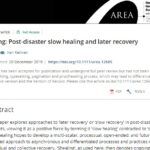Kasia Mika and Ilan Kelman in Area (2020)
This paper explores approaches to ‘later recovery’ or ‘slow recovery’ in post‐disaster contexts, viewing it as a positive force by terming it ‘slow healing’ contracted to ‘shealing’. Slow healing hopes to develop a multi‐scalar, processual, open‐ended, and future‐oriented approach to asynchronous and differentiated processes and practices of individual and collective recovery. ‘Shealing’, as used here, then denotes ongoing, individual and collective efforts through remaking and building one’s life post‐disaster. This process of shealing, of re‐making and making lives liveable, is a process of assembling, or trying to assemble, life and livelihoods, without necessarily immediately eradicating all traces of destruction which might be vestiges of a life before the disastrous manifestation of compound vulnerabilities. Shealing provides an alternative to assumptive, linear approaches in order to enfold healing and vulnerability reduction within day‐to‐day, continual, accepted, non‐spectacular actions. From a noun or an attribute, ‘shealing’ functions as a verb by being a continuous and open‐ended process in the present, not just a defined stage, whether a hoped‐for endpoint or a recovery of some pre‐disaster state. Shealing allows theorising the many ways of living in and through disaster experiences alongside the range of everyday post‐disaster approaches to re‐making one’s life that an individual or community might embrace. Shealing forms a joint scholarly‐practical approach that better addresses what needs to be done and accepted after experiencing a disaster. This paper focuses on disasters, but wider implications and connections emerge, such as for grief, trauma, and social work.
